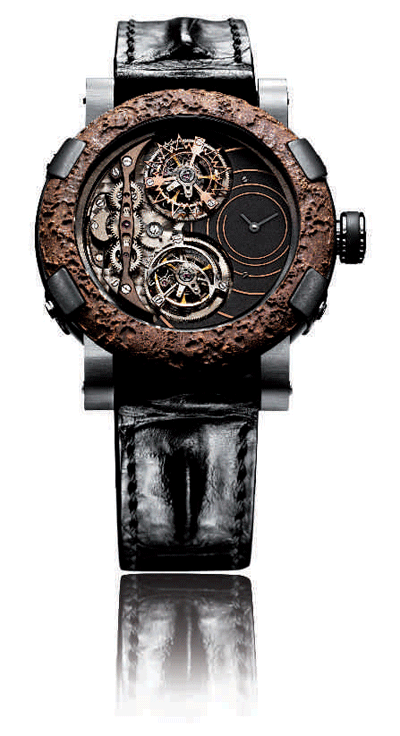Grégory Pons

Romain Jerome Day&Night, Counter, voc
On a market that has provisionally lost its bearings, it's the individual personality of each watch that makes all the difference: there is no longer any question of making do with what exists. Innovate or perish is the leitmotif, and connoisseurs expect to be pampered in every possible respect.
It all starts with the dial, which creates the first visual impact. The hour display is experiencing a new revolution: Urwerk, which had invented the “satellite” hour, will soon be presenting a “linear” hour to be read off by a hand moving along a kind of horizontal counter. For his third Horological Machine, Max Büsser (MB&F) has imagined reading time off in two cone-shaped “towers” placed on top of the watch. Meanwhile, with his Sequential One watch, Denis Giguet (Manufacture Contemporaine du Temps) is reinventing numerical hours engraved on pivoting “paddles”, while Lionel Ladoire patents his three hand-free hour/minute/second indicators mounted on ball bearings in the Roller Guardian Time (Ladoire). One can even find hours read off on rollers (Cabestan) and seconds placed inside a drum on the outside of the watch (Concord)! Be sure not to miss the “track rod” system from Hautlence, nor the more deliberately amusing counting of time as if in slow motion from Hermès (Cape Cod Grandes Heures). Not to mention the very real change of pace imposed by Horus with a movement that actually makes hours pass twice as slowly or twice as fast, before restoring their freedom and catching up with lost time…

Richard Mille RM 021
All of which makes it pretty challenging to assert one's personality with two classic hands. Yet this is exactly what De Bethune achieves in a virtuoso non-conformist display that pushes the boundaries of the watchmaking art. The new Jules Audemars watch from Audemars Piguet lends a new twist to precision chronometers by completely restructuring the movement in an astonishing post-modern architectural approach. The same determination to rewrite the traditional fine arts of watchmaking is shown by François-Paul Journe, who has succeeded in creating a mechanical wrist chronograph capable of cutting up each second into hundredths and of expressing this precision by playing with counters.

De Bethune Dream Watch Two
The extreme refinement of a “skeletonised” movement and the “rough and ready” aesthetic of a BRM express two radically divergent visions of contemporary watchmaking. The very fact that the tourbillon has become so commonplace has forced watchmakers to consider it as merely one component within the overall mechanism, rather than as the central feature – hence the recent proliferation of multi-axis, perpendicular or multiple tourbillons at the heart of a single movement.
The materials revolution can no longer be deemed as such when all the brands subscribe to the same R&D magazines focused on avant-garde metallurgy and research into materials physics. Whether it's ceramised aluminium or sintered ceramics, silicon, titanium or vanadium-niobium, it seems you had better have gained experience in cutting-edge research institutes before designing any watches these days! Romain Jerome has given rust a whole new pedigree, and some brands even evoke pineapple fibre straps and coconut chipboard cases!
The real upheavals actually probably relate to the sociology of the watch. There is a strong trend towards individual personalisation in the choice of colours, the style of the dial and the design of the case: Vacheron Constantin is one step ahead of the crowd with its Quai de l'Ile* model, but luxury watchmaking is now targeting a fully-customised strategy expressed through ultra-limited series.

Ladoire RGT - Roller Guardian Time
Another contemporary tendency is the invention of new ways of wearing a watch, no longer on the wrist but on the end of a chain – like the pocket-watches of yesteryear – or even on an adhesive backing that can be placed on almost anything and can basically no longer even be viewed as watches (S.T.A.M.P.S). Richard Mille and his new RM 020, as well as Piaget, Chaumet and Jaquet Droz have all entered this territory, where we might well see a single watch case moving from the wrist – where it would be housed in a “container” – to the pocket, with additional options as a table clock on a dedicated desk stand and as a wrist instrument clipped to a car dashboard.
The fundamental innovation for 2009 definitely lies in imagining novelty – in terms of movements, watches, their style and even the way in which we look at them!








